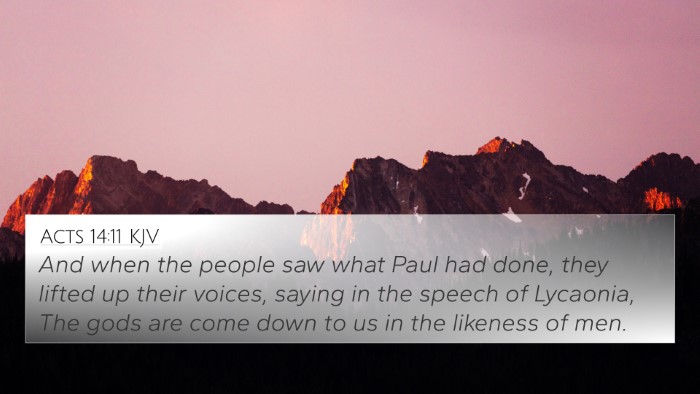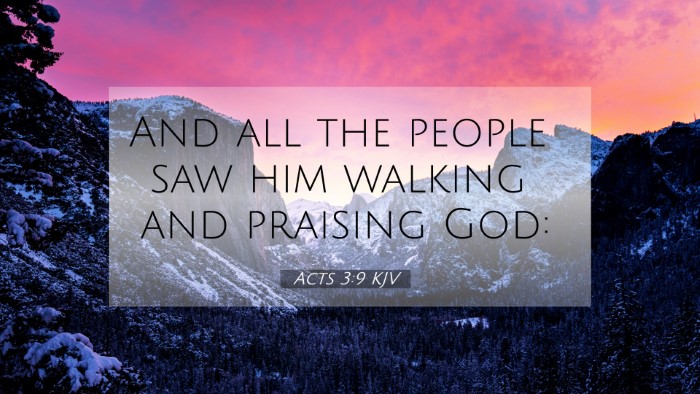Old Testament
Genesis Exodus Leviticus Numbers Deuteronomy Joshua Judges Ruth 1 Samuel 2 Samuel 1 Kings 2 Kings 1 Chronicles 2 Chronicles Ezra Nehemiah Esther Job Psalms Proverbs Ecclesiastes Song of Solomon Isaiah Jeremiah Lamentations Ezekiel Daniel Hosea Joel Amos Obadiah Jonah Micah Nahum Habakkuk Zephaniah Haggai Zechariah MalachiActs 3:9 Similar Verses
Acts 3:9 Cross References
And all the people saw him walking and praising God:
Uncover the Rich Themes and Topics of This Bible Verse
Listed below are the Bible themes associated with Acts 3:9. We invite you to explore each theme to gain deeper insights into the Scriptures.
Acts 3:9 Cross Reference Verses
This section features a detailed cross-reference designed to enrich your understanding of the Scriptures. Below, you will find carefully selected verses that echo the themes and teachings related to Acts 3:9 KJV. Click on any image to explore detailed analyses of related Bible verses and uncover deeper theological insights.

Acts 4:21 (KJV) »
So when they had further threatened them, they let them go, finding nothing how they might punish them, because of the people: for all men glorified God for that which was done.

Acts 4:16 (KJV) »
Saying, What shall we do to these men? for that indeed a notable miracle hath been done by them is manifest to all them that dwell in Jerusalem; and we cannot deny it.

Luke 13:17 (KJV) »
And when he had said these things, all his adversaries were ashamed: and all the people rejoiced for all the glorious things that were done by him.

Acts 14:11 (KJV) »
And when the people saw what Paul had done, they lifted up their voices, saying in the speech of Lycaonia, The gods are come down to us in the likeness of men.
Acts 3:9 Verse Analysis and Similar Verses
Understanding Acts 3:9
Acts 3:9 reads: “And all the people saw him walking and praising God.” This verse describes the aftermath of a miraculous healing performed by Peter and John on a lame beggar at the Beautiful Gate of the Temple. It highlights the reaction of the crowd to the event and illustrates key theological themes found throughout Scripture.
Summary of the Verse's Meaning
In this verse, the emphasis lies on the public recognition of God's power. The healing not only transformed the beggar’s life but also served as a powerful testament to the authority of Jesus and the active work of the Holy Spirit in the early church. The praises offered by the healed man symbolize a personal response of gratitude and faith, serving as an inspiration for others to recognize and glorify God.
Thematic Connections
This verse establishes several thematic connections with other Scriptures, linking the miraculous acts of the Apostles with the ministry of Jesus. The healing serves to validate the message of salvation and the fulfillment of Old Testament prophecies, showcasing the continual work of God through His people.
Bible Cross-References
- Acts 2:43 - "And fear came upon every soul: and many wonders and signs were done by the apostles." This verse parallels the recognition of the supernatural acts performed by the apostles post-Pentecost.
- John 14:12 - "Verily, verily, I say unto you, He that believeth on me, the works that I do shall he do also; and greater works than these shall he do; because I go unto my Father." This supports the concept that believers can perform miracles in Jesus’ name.
- Isaiah 35:6 - "Then shall the lame man leap as a hart, and the tongue of the dumb sing." This Old Testament prophecy about healing ties into the miracle performed by Peter and John.
- Matthew 9:6 - "But that you may know that the Son of Man has authority on earth to forgive sins—he then said to the paralytic—’Rise, pick up your bed and go home.’" This demonstrates Jesus’ authority to heal, a theme that continues with the apostles.
- Luke 17:19 - "And he said unto him, Arise, go thy way: thy faith hath made thee whole." This illustrates faith as a key component in receiving healing.
- John 9:3 - "Jesus answered, Neither hath this man sinned, nor his parents: but that the works of God should be made manifest in him." Focusing on God's purpose behind suffering and healing illustrates a theological continuity.
- 2 Corinthians 1:20 - "For all the promises of God in him are yea, and in him Amen, unto the glory of God by us." This relates to the fulfillment of God's promises seen in miraculous healings and actions.
- Psalms 107:20 - "He sent his word, and healed them, and delivered them from their destructions." This emphasizes the power of God’s word in healing, a theme echoed in the New Testament.
- Acts 4:30 - "By stretching forth thine hand to heal; and that signs and wonders may be done by the name of thy holy child Jesus." This shows the ongoing nature of God’s healing and miraculous signs through the apostles.
- Romans 15:18-19 - "For I will not dare to speak of any of those things which Christ hath not wrought by me, to make the Gentiles obedient, by word and deed, through mighty signs and wonders, by the power of the Spirit of God." This reinforces the idea that the apostles’ miracles were instrumental in spreading the Gospel.
Interpretative Insights from Commentaries
Insights from Matthew Henry suggest that the act of praising God was not only an expression of personal gratitude but also a public testimony to God's grandeur. Henry emphasizes the importance of faith, stating that true healing encompasses both body and spirit. Albert Barnes also points out the significance of this event in the early church as it serves to reinforce the apostles’ legitimacy as messengers of Christ, showcasing that their actions were an extension of Jesus' earthly ministry. Adam Clarke draws attention to the societal implications of the miracle, noting how the healed beggar’s public display of joy and praise would have impacted the community around him, thus fostering a greater awareness of God’s workings in their midst.
Applications for Today
The act of praising and recognizing God in our lives is a powerful testimony to those around us. Just like the healed beggar, individuals today are called to proclaim the goodness of God, showcasing the transformative power of faith. By examining the connections between Scripture and the actions of the apostles, one can grasp a deeper understanding of God’s ongoing work in the world and in their personal lives.
Conclusion
Acts 3:9 serves as a rich source for reflection on the themes of healing, faith, and public testimony. Through cross-referencing this verse with related Scriptures, believers gain insights into the interconnectedness of God's promises and acts throughout the Bible, fostering a greater understanding of His purpose and movement throughout history.
Identifying Connections in Scripture
For those studying the Bible, understanding how to find cross-references can enhance one’s biblical literacy. Utilizing tools such as Bible concordances or cross-reference guides provides clarity on how various verses relate to each other, leading to a more profound appreciation of Scripture's cohesive narrative.



